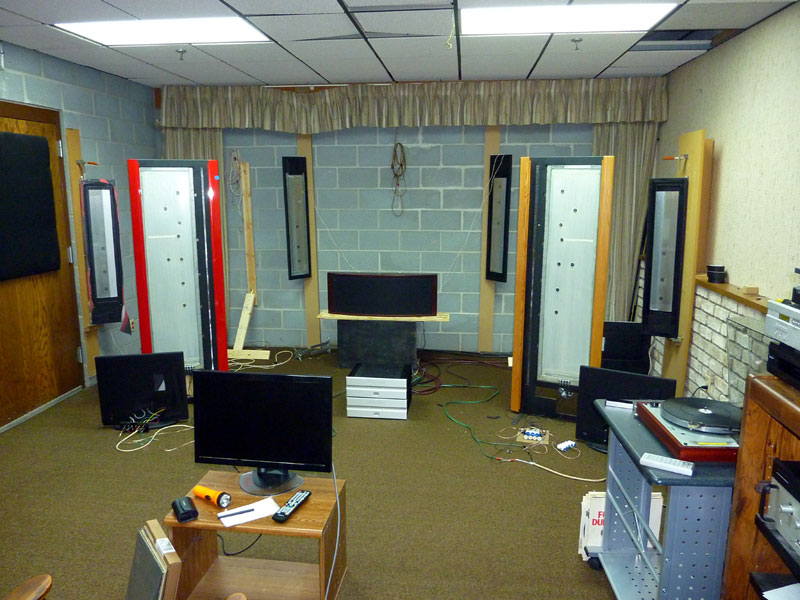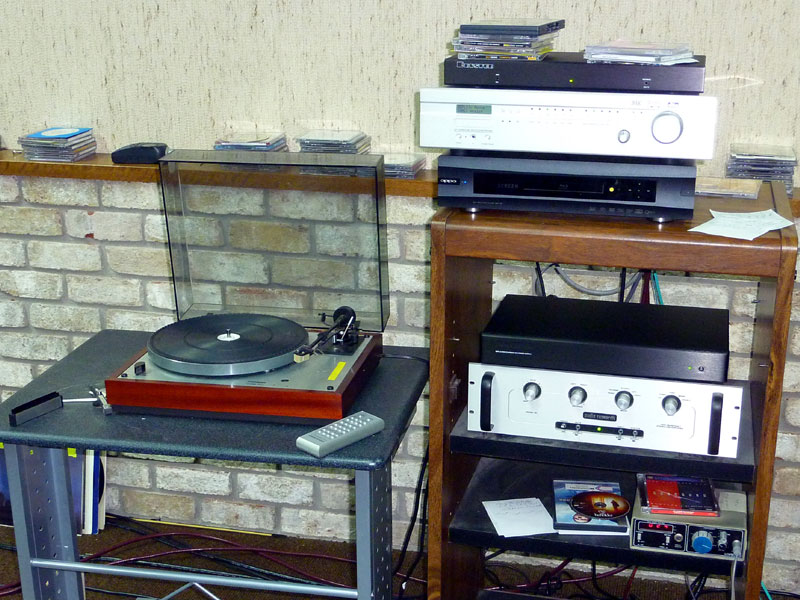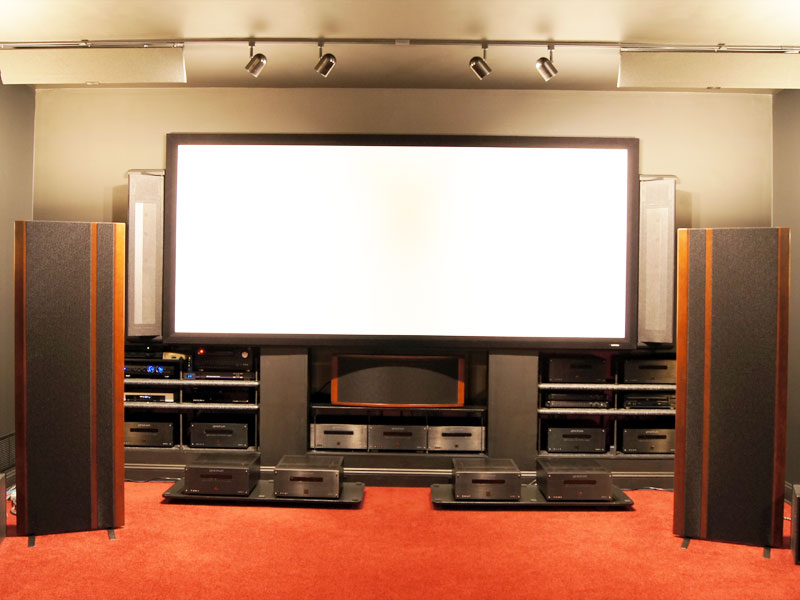Magnepan's 3.7/Tri-Center System: The Second Time Around
normally visit Minneapolis in the summer to catch up with the companies headquartered there. This year, however, my annual trip came earlier than usual -- at the end of April, when there's still a chance of snow. Ready for anything, I spent the better part of two days at Magnepan and Audio Research, hearing what both companies had been working on. At Audio Research, I heard the new Reference 250 mono amps. At Magnepan, I heard a new configuration of existing products -- a system that Magnepan's Wendell Diller considers a new wrinkle in two-channel listening.
Magnepan's listening room is more laboratory than music parlor. The system used Magnepan 3.7s ($5495 or $5895 per pair, depending on trim option) along with the company's Tri-Center, which consists of a pair of motorized MMC2 wall-mounted speakers ($1995/pair) and a CCR center-channel speaker ($2995). Electronics were an integral part of the system and consisted of a Bryston SP2 surround-sound processor ($6795), which was used to direct stereo signals to the speakers, and a Bryston 9B SST2 multichannel amp ($7900). The source was a modified Denon DVD-3910 universal A/V player, which was connected to the Bryston processor by its XLR stereo outputs. The "stereo" part was important. This system may have looked like it was decked out for playing movies, but it was all about music, stereo music. At the push of a button on the Bryston processor's remote, I could toggle between the 3.7s with and without the Tri-Center, the Bryston processor handling the steering of the stereo signals in either case. The difference between the two presentations was dead obvious and completely in favor of the Tri-Center system. There's nothing wrong with the 3.7s alone; on the contrary, there's a lot that's right with them, including the directness and clarity throughout their range. However, with the Tri-Center, the presentation was more three-dimensional, more present, more powerfully real. After an hour of listening, I asked Wendell the eternal question: "Can you send this system to me?" I wanted to write about it -- had to write about it in greater depth than the short demo would allow. We immediately made plans for a review, which included shipping all of the speakers and the electronics. Wendell would fly to Arizona to aid in the setup, and, as easy as that, I'd break the full story on this significant enhancement to stereo listening -- with Magnepan speakers, at least. Then, as it does, reality set in. Wendell and I talked shortly after I returned home to make arrangements for the review. Shipping the speakers and electronics to Arizona, as well as Wendell himself, was cost prohibitive but possible. The larger issue was setting up the system, especially the Tri-Center, in my room, which has no usable front wall (it's a row of French doors). When, during our discussions, Wendell used the term "false wall," I was sold on experiencing the system in an alternate way, and the best of these involved another trip to the Upper Midwest. So I was in Minneapolis in the summer after all, this time to hear the Magnepan/Bryston system at length. The lineup had changed somewhat in the interim -- superficially for the most part, except for one significant addition. The speakers remained the same, but the Bryston multichannel amp was replaced by a pair of 4B SST2 stereo amps, and an Oppo BDP-95 ($999) replaced the modified Denon universal player. The addition was a Thorens TD 166 turntable with unidentified vintage cartridge (it looked like a Denon), which was used along with Bryston's BP-1.5 C-Series phono stage ($3195). The analog rig underscored the purpose of the system: stereo listening, not home theater.
I brought along a number of demo CD-Rs and a few LPs too. Magnepan had shelves of LPs in the back of the demo room, many of which were sought-after audiophile oldies that (sadly) hadn't been played in decades. Over the course of the day, I listened extensively to digital and analog, and as with my earlier audition, I was able to toggle between speaker systems at the push of a button. However, after a certain point within the first hour, switching back and forth became an academic exercise only. More to come on that. What it did and didn't
s TAB readers are aware, Wendell Diller has been noodling with the concept of a multi-speaker array for some time. I first heard and wrote about the Tri-Center nearly two years ago, and John Crossett wrote about a system that included Magnepan MMC2s, a pair of Magnepan woofers and Magnepan’s CC5 center-channel speaker last year. With all of this in mind, I asked Wendell how he had refined his approach and discovered the 3.7/Tri-Center system. He remarked, "I can't remember exactly. . . . I believe I was just messing around with processor functions as if I had a Maggie home-theater system." Accident, it turns out, is also the mother of invention. There are some special qualities about the 3.7, including fleet highs from the speaker's ribbon tweeter, a midrange that's more neutral and transparent than that of speakers costing ten times as much, and a well-integrated, meaty bottom end that the model it replaced couldn't equal. The 3.7's bass would cause me to question using a subwoofer, let alone adding a three-speaker array that duplicates a large swath of the treble and midrange. Perceptually, then, the 3.7/Tri-Center system begins at a deficit. However, listening tells a completely different story. Switching in the Tri-Center immediately and obviously caused the soundstage to swell laterally and especially in terms of depth, creating an arc of music that filled the front third of the listening space. This presentation never seemed like the product of sonic chicanery -- that the Bryston processor was manipulating the signal to give the illusion of a bigger, more home-theater-appropriate soundscape, for instance. Focus was just as acute, but the traditional sweet spot widened, making for a presentation that was less discrete and more continuous in terms of image placement.
A customer installation. Tonality wasn't altered at all, although the density of the soundstage would fool some listeners into thinking it was. If anything, there was enhanced fullness, especially in the lower midrange and below, giving the bass range greater heft. A Jacques Lousier track from his Telarc release Bach: The Brandenburgs [Telarc CD-83644] had a sense of physicality that was thrilling, and all the while Lousier's piano careened around the front third of the room. Some of the classical LPs Wendell played displayed the same solidity and movement better than others, illustrating that some simply didn't have the inherent quality to take full advantage of what the system did so well. Telarc's early version of The Firebird Suite [Telarc DG-10039] was undeniably impressive -- engulfing, massively powerful, and as big as the room would allow. It was with this piece that switching between the stereo 3.7s and the speakers with the Tri-Center proved fruitless in terms of comparing the two presentations, as there was really no comparison between them. The Tri-Center was all gain, even with more quaint fare such as After the Ball [Nonesuch 79148-2], a collection from husband-and-wife team William Bolcom and Joan Morris of songs popular before the recording era began. Here it wasn't the power of the music that was impressive, but rather the in-room presence of the performers -- pianist and mezzo-soprano. Such lovely, lilting music that the ribbon tweeter of the 3.7s and CCR served so well. Ultimately, a system such as this raises a number of questions about why it works. Magnepan speakers are dipoles, emitting sound front and rear. More such sound sources would certainly have an effect on the perceived fullness of the presentation, but that was only part of the story here, as the soundscape was more realistically rendered right to left and front to back. There are also the electronics, the Bryston SP2 specifically. This surround-sound processor steers the signals to the speakers, essentially processing stereo sound for three speakers. What exactly is it doing? In all likelihood, not much. As I toggled between strict stereo and the 3.7/Tri-Center system, I listened for shifts in image placement that would indicate the BP2 was synthesizing stereo into three channels, and I never heard them. The Tri-Center, therefore seems mandatory, and indeed Wendell admits that the CCR or the MMC2s by themselves "won't do the magic." "The Tri-Center is complex. We know there is direct and reflected energy. We know the power response is different from that of conventional center-channel speakers." However, in terms of theories, Wendell admits, "I really don't understand why it works." He jokes, "We have stumbled upon the formula for 'cold fusion.'" The 3.7/Tri-Center system obviously requires more real estate than a single pair of 3.7s, which themselves are not the sort of speakers you should cram into a smallish room. And the system is not cheap either. However, I've had MG20.1s in my listening room, and the 3.7s with the Tri-Center were better still, offering the midrange transparency and soundstage continuousness of Magnepan's biggest speaker, but filling out the soundstage in a more convincing way. Wendell was quick to point out, however, that a similar system could be built around the 1.7s ($1995 per pair) and CC5 center-channel speaker ($1095). He also speculates that the same thing could be possible with other brands of panel speakers. Two unresolved issues remain with the 3.7/Tri-Center
system. It needs exposure -- either at dealers or shows. CES would be the perfect venue,
giving dealers and the press a chance to hear it. Second, it needs a name, and not just
one that's functional -- something catchy that people will remember. Send all suggestions
to Wendell Diller. |



